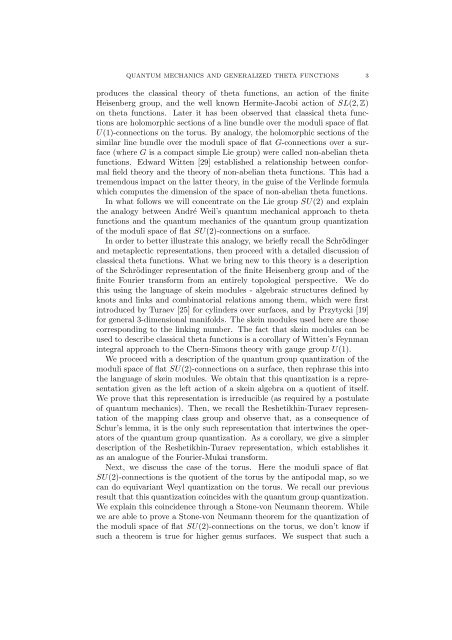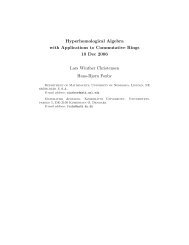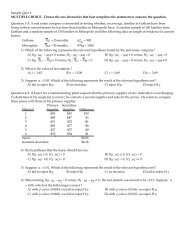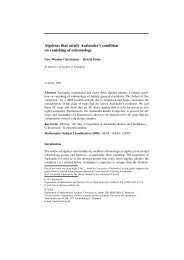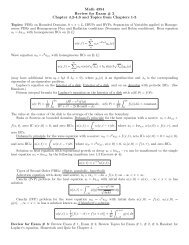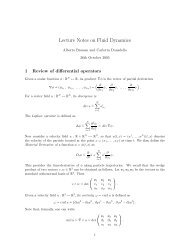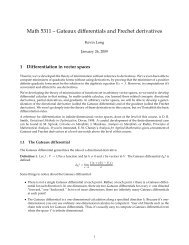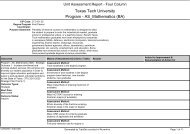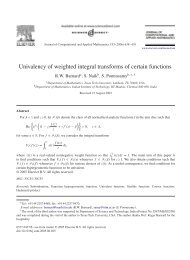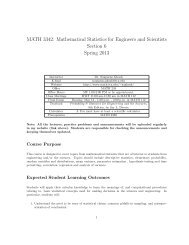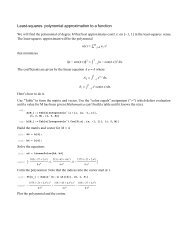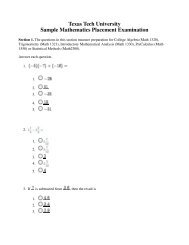QUANTUM MECHANICS AND NON-ABELIAN THETA FUNCTIONS ...
QUANTUM MECHANICS AND NON-ABELIAN THETA FUNCTIONS ...
QUANTUM MECHANICS AND NON-ABELIAN THETA FUNCTIONS ...
You also want an ePaper? Increase the reach of your titles
YUMPU automatically turns print PDFs into web optimized ePapers that Google loves.
<strong>QUANTUM</strong> <strong>MECHANICS</strong> <strong>AND</strong> GENERALIZED <strong>THETA</strong> <strong>FUNCTIONS</strong> 3produces the classical theory of theta functions, an action of the finiteHeisenberg group, and the well known Hermite-Jacobi action of SL(2, Z)on theta functions. Later it has been observed that classical theta functionsare holomorphic sections of a line bundle over the moduli space of flatU(1)-connections on the torus. By analogy, the holomorphic sections of thesimilar line bundle over the moduli space of flat G-connections over a surface(where G is a compact simple Lie group) were called non-abelian thetafunctions. Edward Witten [29] established a relationship between conformalfield theory and the theory of non-abelian theta functions. This had atremendous impact on the latter theory, in the guise of the Verlinde formulawhich computes the dimension of the space of non-abelian theta functions.In what follows we will concentrate on the Lie group SU(2) and explainthe analogy between André Weil’s quantum mechanical approach to thetafunctions and the quantum mechanics of the quantum group quantizationof the moduli space of flat SU(2)-connections on a surface.In order to better illustrate this analogy, we briefly recall the Schrödingerand metaplectic representations, then proceed with a detailed discussion ofclassical theta functions. What we bring new to this theory is a descriptionof the Schrödinger representation of the finite Heisenberg group and of thefinite Fourier transform from an entirely topological perspective. We dothis using the language of skein modules - algebraic structures defined byknots and links and combinatorial relations among them, which were firstintroduced by Turaev [25] for cylinders over surfaces, and by Przytycki [19]for general 3-dimensional manifolds. The skein modules used here are thosecorresponding to the linking number. The fact that skein modules can beused to describe classical theta functions is a corollary of Witten’s Feynmanintegral approach to the Chern-Simons theory with gauge group U(1).We proceed with a description of the quantum group quantization of themoduli space of flat SU(2)-connections on a surface, then rephrase this intothe language of skein modules. We obtain that this quantization is a representationgiven as the left action of a skein algebra on a quotient of itself.We prove that this representation is irreducible (as required by a postulateof quantum mechanics). Then, we recall the Reshetikhin-Turaev representationof the mapping class group and observe that, as a consequence ofSchur’s lemma, it is the only such representation that intertwines the operatorsof the quantum group quantization. As a corollary, we give a simplerdescription of the Reshetikhin-Turaev representation, which establishes itas an analogue of the Fourier-Mukai transform.Next, we discuss the case of the torus. Here the moduli space of flatSU(2)-connections is the quotient of the torus by the antipodal map, so wecan do equivariant Weyl quantization on the torus. We recall our previousresult that this quantization coincides with the quantum group quantization.We explain this coincidence through a Stone-von Neumann theorem. Whilewe are able to prove a Stone-von Neumann theorem for the quantization ofthe moduli space of flat SU(2)-connections on the torus, we don’t know ifsuch a theorem is true for higher genus surfaces. We suspect that such a


